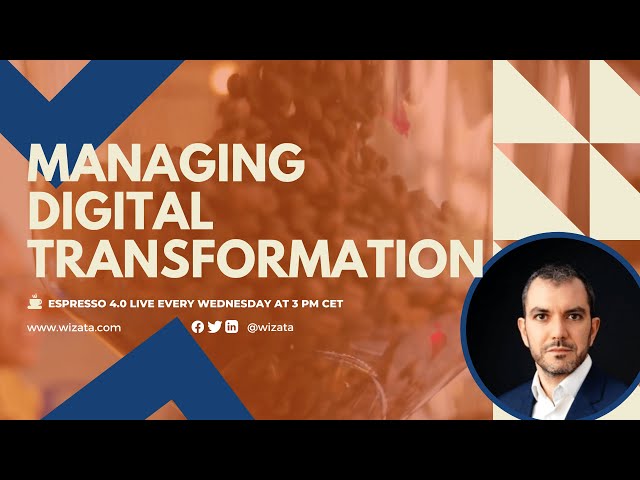![]() Espresso 4.0 by
Espresso 4.0 by
Wizata
Happy to have you in Espresso 4.0. We can jump right into it. Can you give us an intro to Marco Piccio?
Sure. I have 15 years of experience in continuous improvement, process excellence, and business transformation in different industries. I have an experience in manufacturing, electronics, and even B2C service.
Now I'm working for CDL, part of the Traveler Group, where I'm managing business transformation at the global level. And so, my entire career has been focused on improvement and, recently, on business and digital transformation.
You obviously have a multifaceted experience and continuous improvement, and now you're in part of your running a project in Digital Transformation, and that's all the hype right now. Industry 4.0, smart manufacturing is a holy grail, and one of the ways we get to it is with digital transformation.
Starting the Digital Transformation Journey
A lot of companies are embarking on that kind of adventure. However, they risk taking the wrong turn and getting the wrong tool without answering a very important question: why are we going through digital transformation? Why are we developing or buying a tool?
How important is it that the companies answer this before they embark on a digital transformation project?
Answering the question “why” has to be the starting point. I would say it's mandatory. Clearly defining and writing down the why of a project program or a simple initiative is key for two main reasons.
The first one is that it helps clarify the real need for a particular tool or system or, in which terms, in which framework is needed. This is particularly important for the project leader to clarify the real reason why the initiative is needed.
Also, it's extremely useful for a deep discussion with the main stakeholders, including the project sponsor. This is quite a turning point for me because sometimes the leader cannot explain “why.” If this happens, we have an issue and should question the need for that project or that specific tool.
The second reason, which is even more important, is that being able to explain the “why” is especially important because you have to explain it to end users.
“People don't buy what you do; they buy why you do it.”
Let’s say that, in general, the end users are the internal customers of your system implementation. As Simon Sinek well-said: “People don't buy what you do; they buy why you do it.” The “why” is fundamental to facilitating, involving, and engaging the end user.
That is the foundation of change management, and there is no worse thing than jumping in and explaining what people have to do and how the new tool is working without explaining why we need it and why we are going for this implementation first.
That's why when I provide methodological support to businesses, all the templates I build for a workshop or a training session have the same first page, which is “why this project.”
Importance of Culture
You've mentioned stakeholders and the importance of change management and training. So, let's assume you've answered your question “why,” you've chosen your vendor, or you've tasked your team with developing a solution, a tool that's going to help with digital transformation, or it's part of your digital transformation strategy.
But that's only the beginning of the battle. Just like you said, a lot of companies run the risk of failing in the implementation phase because of culture. That's where change management comes in.
Can you expand on that? Why and how is culture important? How do we avoid the risks of having a failed project instead? What are some of the solutions?
Culture is fundamental for a simple reason; in the end, technology is an enabler. But companies are made of people, and people drive systems and tools. People have to make the best use of those tools and release their full potential to increase the value delivered to final customers.
People are the driving force empowering digital transformation. In the digital transformation era, the motto should not be technology first but people first. And approaching transformation from a human perspective is essential because people have to experience this change positively.
And not only do they have to embrace it, but they also have to become enablers of the change. Here, we come back to the previous point about the importance of explaining the “why.” And as you mentioned correctly, this has to be leveraged by change management.
The value proposition is only one part of the equation. What is key is the change of mindset. And it might be particularly painful, especially for all the organizations with old-style management.
That's why sustaining digital transformation from the beginning is important, as cultural change might take time. It does not happen overnight. And especially if we consider that the rise of technology is much faster than the cultural change.
The Concept of Uncertainty
Technology change, technology transformation, and digital transformation are exponential, while, if we are lucky, cultural change is linear or even slower than that. A couple of points that can facilitate these are to instill the concept of uncertainty.
This can be counterintuitive, but this is to be seen in opposition to certainty, which is somehow bad because it is associated with the idea of steadiness. The worst thing you can hear is the employee resistance to automation. “We have always done it like that.” How many times did you hear that?
But when you have new ideas, tools, and a new way of working associated with uncertainty, you must embrace that. Things might change, and things might change quickly. This comes together with a sense of urgency. We need to do it in a reasonable time frame if we do a digital transformation in a digital environment ten years out of business.
Those two concepts are important because working on them means that you have to work on your mindset and work from the beginning and every day because this is a continuous process.
Lastly, you need to involve your customers in the process since you might think you know what your customers want. Customer perspective evolves almost as quickly as technology does. Being able to involve your customers and ask the right question is key to being on the right path.
Importance of Staff Training
Marco, you put a lot of effort into training the staff to adopt new tools you acquire as part of the digital transformation to communicate its purpose.
I'd like you to explain to us why that's important and some of the traps that companies fall in without transparency across the stakeholders and the right communication as to the purpose of certain tools, as well as the training in terms of adoption and use.
You're right, Philip. As you said, this is a dangerous pitfall. You might have the money and resources to implement a fantastic state-of-the-art tool, but nobody is using it. If I look back at my experience, one reason could be that we have failed to explain the “why,” as we said in the beginning, or that we are not yet in the right mindset, and we come to the second point about culture.
But there is another key reason. It's that very often proper training is missing. Training is not missing completely, sometimes it happens, but adequate training is a fundamental element of business transformation.
I've seen a new system implemented very often by an external supplier, and the training is just the technical manual provided by the supplier. In this case, don't be surprised if the end-user adoption is low or the tool is used at 5% of its potential.
Importance of Change Agents
A solution to this problem is having change agents, or process drivers, as some companies call them. They take care of the training, starting with training material. And again, when we talk about change agents, we connect to the previous points.
They are involved enablers of the change, and it's essential because they know the company's culture, so they know how to touch the right point or deliver the right message. To have an effective training and training materials, you have to explain the “why” and the process itself.
The process behind the tool is important because, first of all, you have to have a process behind it; if not, if you discover you don't, we have an issue because we might question how the system has been designed.
The process also helps understand the system from a non-technical point of view. This is key to achieving end-user adoption as the process is, in the end, the way of working that has inspired the system implementation. So, explaining the tool is part of the process.
Concept of Modular Training
There is also a challenge of how to deliver training to a large, not homogenous population. You might be tempted to go back to the idea of having the supplier provide the training, or you might feel overwhelmed by this.
What I found very useful and what I have adopted is the concept of modular training. You can split your training material into different sections and different modules. To make a dummy example, you might have an awareness module, a process understanding module, and a technical module, which is a deep dive into the system.
This is useful because you can adapt the training material to the audience while preparing just one module at a time. For example, stakeholders, touched at a high level by the system, can stay with the awareness module. In contrast, people who are more involved daily can go for the process understanding module on top of the awareness one.
After that, you can add the technical module to people who have to work in a deeper way with the system and the tool. And this is a simple dummy example, but it helps you understand that you can play in different ways. This approach is very useful to touch a large, not homogeneous population, and it works well.
Collaborating With the Suppliers
Some vendors provide training material or manuals on how to use tools. Do you collaborate with suppliers? How important is the supplier? Should they be involved?
They should be involved. I didn’t want to say earlier that the supplier should be excluded because, in 95% of the cases, the implementation is led or done by the suppliers. This has to be partnership work, a joint work between the supplier and the internal people. I questioned a little bit when we delegated everything to the supplier, including the training.
So, there has to be a technical partner, and suppliers are often our partners. They know our company and work with us, so they are key in helping us deliver the system and build the training material, especially concerning the technical part.
Delegating in full debt to suppliers might be dangerous because, in the end, the supplier is providing the system implementation and technical material. They might provide the training, but then in a few weeks, they are gone.
We could change the process after a couple of months, which can be easily configured in the tool but might not be reflected in the training material. And here, we come back to the previous point of modular training. You might have a big manual, as big as a dictionary, but also people who never open it.
Not only that, but you also have different ways today to deliver training. You can have eLearning, smaller modules that are delivered online. People can do that whenever they want. So, coming back to your question, it's okay that suppliers are involved. On the contrary, the suppliers are likely involved. They must partner with the company's change agents, especially regarding training.
Any successful digital transformation involves both parties, the supplier and the customer.



